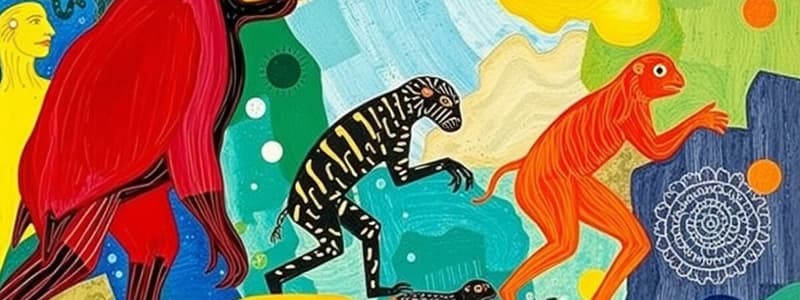Podcast
Questions and Answers
What is one of the mechanisms of biological evolution that involves non-random mating benefits?
What is one of the mechanisms of biological evolution that involves non-random mating benefits?
- Mutation
- Natural selection
- Sexual selection (correct)
- Gene flow
Which pillar of natural selection explains the survival advantage of individuals able to compete effectively?
Which pillar of natural selection explains the survival advantage of individuals able to compete effectively?
- Variation
- Mutation
- Heritability
- Competition (correct)
What does heritability refer to in the context of natural selection?
What does heritability refer to in the context of natural selection?
- The adaptation of species to their habitats
- The passing of variations to offspring (correct)
- The ability of traits to evolve quickly
- The chance of survival in changing environments
What is a common misconception about population growth as per natural selection?
What is a common misconception about population growth as per natural selection?
In the study of genetics, what term describes the observable characteristics of an organism?
In the study of genetics, what term describes the observable characteristics of an organism?
Which of the following statements is true regarding genetic variation?
Which of the following statements is true regarding genetic variation?
Which theorist conducted significant early studies on inheritance that influenced the understanding of genetics?
Which theorist conducted significant early studies on inheritance that influenced the understanding of genetics?
Why are some evolutionary adaptations observed to have no immediate survival benefits?
Why are some evolutionary adaptations observed to have no immediate survival benefits?
Flashcards
Natural Selection
Natural Selection
Process where organisms better adapted to their environment tend to survive and produce more offspring.
Sexual Selection
Sexual Selection
Natural selection arising through preference by one sex for certain characteristics in individuals of the other sex.
Genetic Drift
Genetic Drift
Random fluctuations in allele frequencies in a population.
Gene Flow
Gene Flow
Signup and view all the flashcards
Mutation
Mutation
Signup and view all the flashcards
Heritability
Heritability
Signup and view all the flashcards
Exponential population growth
Exponential population growth
Signup and view all the flashcards
Alleles
Alleles
Signup and view all the flashcards
Study Notes
Diversity of Life
- Earth is home to approximately 8.7 million species.
- Explaining this vast diversity has challenged scientific understanding throughout history.
- Debates about evolutionary theories, including disagreements with natural selection, persist.
Mechanisms of Biological Evolution
- Five primary mechanisms drive biological evolution:
- Natural selection
- Sexual selection
- Genetic drift
- Gene flow
- Mutation
Observations Before Darwin & Wallace
- Life forms change over time.
- Biological characteristics serve specific functions.
Darwin & Wallace's Explanatory Challenge
- Understanding the why of evolutionary changes.
- Explaining the origin of new species.
- Determining the purpose of physical traits.
The Origin of Species (1859)
- Three key pillars underpin natural selection:
- Competition:
- Unlimited resources lead to exponential population growth, resulting in a struggle for existence.
- Variation:
- Individuals vary in their competitive abilities.
- Individuals with advantageous variations are more likely to survive and reproduce.
- Heritability:
- Variations are inheritable, passed down through generations.
- Differential reproductive success drives evolutionary changes in populations.
- Competition:
Natural Selection Scrutinised
- Population growth: Populations do exhibit exponential growth.
- Sufficient time: Enough time has passed for evolution to occur.
- Heritability of variation: Variation is indeed heritable.
- Sexual dimorphism: Some traits, seemingly disadvantageous for survival, arise from sexual selection, primarily affecting reproduction.
Genes
- Genes dictate both physical appearance and internal bodily functions.
- They contain instructions for protein synthesis.
- Proteins form the body's structure and are integral to life processes.
- Genes reside on DNA strands.
- Gregor Mendel (1865) described that organisms inherit two alleles (versions) of a gene per trait, one from each parent.
- DNA replicates and is passed to offspring.
- Genotype: The genetic makeup of an organism.
- Phenotype: The observable physical characteristics of an organism.
- Genetic Variation Sources:
- Sexual reproduction
- Mutations
- Genetic drift
- Gene flow
The Selfish Gene
- At the heart of biological evolution is the gene, not the individual or trait.
- Genes are self-serving.
- Biological fitness relates to the number of copies of genes passed into future generations.
Sexual Selection
- Intersexual selection (mate choice): One sex (usually female) chooses a mate based on traits.
- Intrasexual selection (competition): Individuals compete within a sex for mates, often involving physical combat or vying for resources.
Human Evolution
- A detailed evolutionary history of the human species is not provided in the text.
Studying That Suits You
Use AI to generate personalized quizzes and flashcards to suit your learning preferences.




